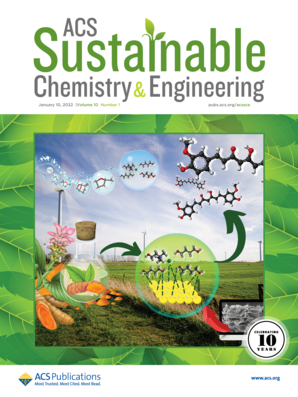锚定在缺陷工程氮掺杂石墨烯上的铁单原子催化剂揭示了二氧化碳还原活性与稳定性之间的相互作用
IF 7.1
1区 化学
Q1 CHEMISTRY, MULTIDISCIPLINARY
引用次数: 0
摘要
氮掺杂石墨烯(NG)中空位的精确工程为稳定金属单原子催化剂(SACs)和调节其催化性能提供了一种有前途的策略。利用密度泛函理论(DFT)探讨了NG中空位在稳定铁基SACs (Fe-SACs)中的作用。首先,我们研究了石墨烯和石墨烯载体中各种空位类型的稳定性,解决了特定结构缺陷优先形成作为金属结合潜在位点的问题。我们揭示了空位稳定性的简单规则,并表明氮掺杂可以带来空位愈合。我们确定了铁原子/离子的首选结合位点,特别是单空位和双空位,并分析了空位中氮掺杂模式如何影响铁与SAC载体的相互作用。结果表明,氮的位置和局部电荷环境对Fe-SACs的稳定性有显著影响。值得注意的是,一些Fe@NG构型,虽然不是最热力学稳定的,但表现出增强的催化性能,特别是对于CO2还原反应(CO2RR)。这些发现为空位工程作为设计高性能fe - sac的策略提供了有价值的见解,并强调了空位类型、氮浓度和催化剂稳定性在驱动催化行为方面的相互作用。本文章由计算机程序翻译,如有差异,请以英文原文为准。

Iron Single-Atom Catalysts Anchored on Defect-Engineered N-Doped Graphene Reveal an Interplay between CO2 Reduction Activity and Stability
The precise engineering of vacancies in nitrogen-doped graphene (NG) presents a promising strategy for stabilizing metal single-atom catalysts (SACs) and tuning their catalytic performance. We explore the role of vacancies in NG for stabilizing iron-based SACs (Fe-SACs) by using density functional theory (DFT). First, we examine the stability of various vacancy types in graphene and NG supports, addressing the question of preferential formation of specific structural defects as potential sites for metal binding. We reveal simple rules governing the stability of vacancies and show that nitrogen doping can bring about vacancy healing. We identify preferred binding sites for Fe atoms/ions, specifically single and double vacancies, and analyze how the nitrogen-doping pattern in a vacancy affects the interaction of Fe with the SAC support. The results show that the positions of nitrogen(s) and the local charge environment significantly influence the stability of the Fe-SACs. Notably, some Fe@NG configurations, although not the most thermodynamically stable, exhibit enhanced catalytic performance, particularly for a CO2 reduction reaction (CO2RR). These findings offer valuable insights into vacancy engineering as a strategy for designing high-performance Fe-SACs and emphasize the interplay among vacancy types, nitrogen concentration, and catalyst stability in driving the catalytic behavior.
求助全文
通过发布文献求助,成功后即可免费获取论文全文。
去求助
来源期刊

ACS Sustainable Chemistry & Engineering
CHEMISTRY, MULTIDISCIPLINARY-ENGINEERING, CHEMICAL
CiteScore
13.80
自引率
4.80%
发文量
1470
审稿时长
1.7 months
期刊介绍:
ACS Sustainable Chemistry & Engineering is a prestigious weekly peer-reviewed scientific journal published by the American Chemical Society. Dedicated to advancing the principles of green chemistry and green engineering, it covers a wide array of research topics including green chemistry, green engineering, biomass, alternative energy, and life cycle assessment.
The journal welcomes submissions in various formats, including Letters, Articles, Features, and Perspectives (Reviews), that address the challenges of sustainability in the chemical enterprise and contribute to the advancement of sustainable practices. Join us in shaping the future of sustainable chemistry and engineering.
 求助内容:
求助内容: 应助结果提醒方式:
应助结果提醒方式:


